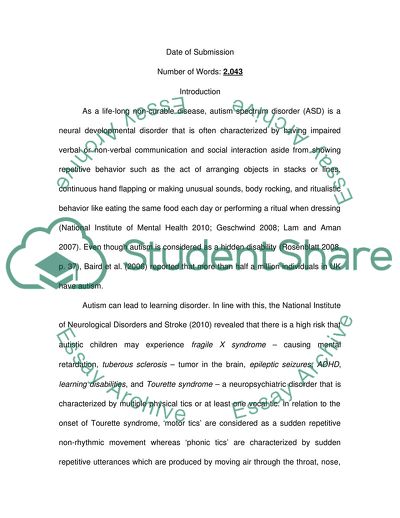Cite this document
(Autism: Speech and Language Therapy Case Study Example | Topics and Well Written Essays - 2000 words - 1, n.d.)
Autism: Speech and Language Therapy Case Study Example | Topics and Well Written Essays - 2000 words - 1. Retrieved from https://studentshare.org/health-sciences-medicine/1751969-discuss-the-significance-of-an-understanding-of-typical-language-and-communication-development-for-a-practitioner-working-with-people-with-autismillustrate-your-answer-by-making-reference-to-the-literature-and-your-practice
Autism: Speech and Language Therapy Case Study Example | Topics and Well Written Essays - 2000 words - 1. Retrieved from https://studentshare.org/health-sciences-medicine/1751969-discuss-the-significance-of-an-understanding-of-typical-language-and-communication-development-for-a-practitioner-working-with-people-with-autismillustrate-your-answer-by-making-reference-to-the-literature-and-your-practice
(Autism: Speech and Language Therapy Case Study Example | Topics and Well Written Essays - 2000 Words - 1)
Autism: Speech and Language Therapy Case Study Example | Topics and Well Written Essays - 2000 Words - 1. https://studentshare.org/health-sciences-medicine/1751969-discuss-the-significance-of-an-understanding-of-typical-language-and-communication-development-for-a-practitioner-working-with-people-with-autismillustrate-your-answer-by-making-reference-to-the-literature-and-your-practice.
Autism: Speech and Language Therapy Case Study Example | Topics and Well Written Essays - 2000 Words - 1. https://studentshare.org/health-sciences-medicine/1751969-discuss-the-significance-of-an-understanding-of-typical-language-and-communication-development-for-a-practitioner-working-with-people-with-autismillustrate-your-answer-by-making-reference-to-the-literature-and-your-practice.
“Autism: Speech and Language Therapy Case Study Example | Topics and Well Written Essays - 2000 Words - 1”. https://studentshare.org/health-sciences-medicine/1751969-discuss-the-significance-of-an-understanding-of-typical-language-and-communication-development-for-a-practitioner-working-with-people-with-autismillustrate-your-answer-by-making-reference-to-the-literature-and-your-practice.


